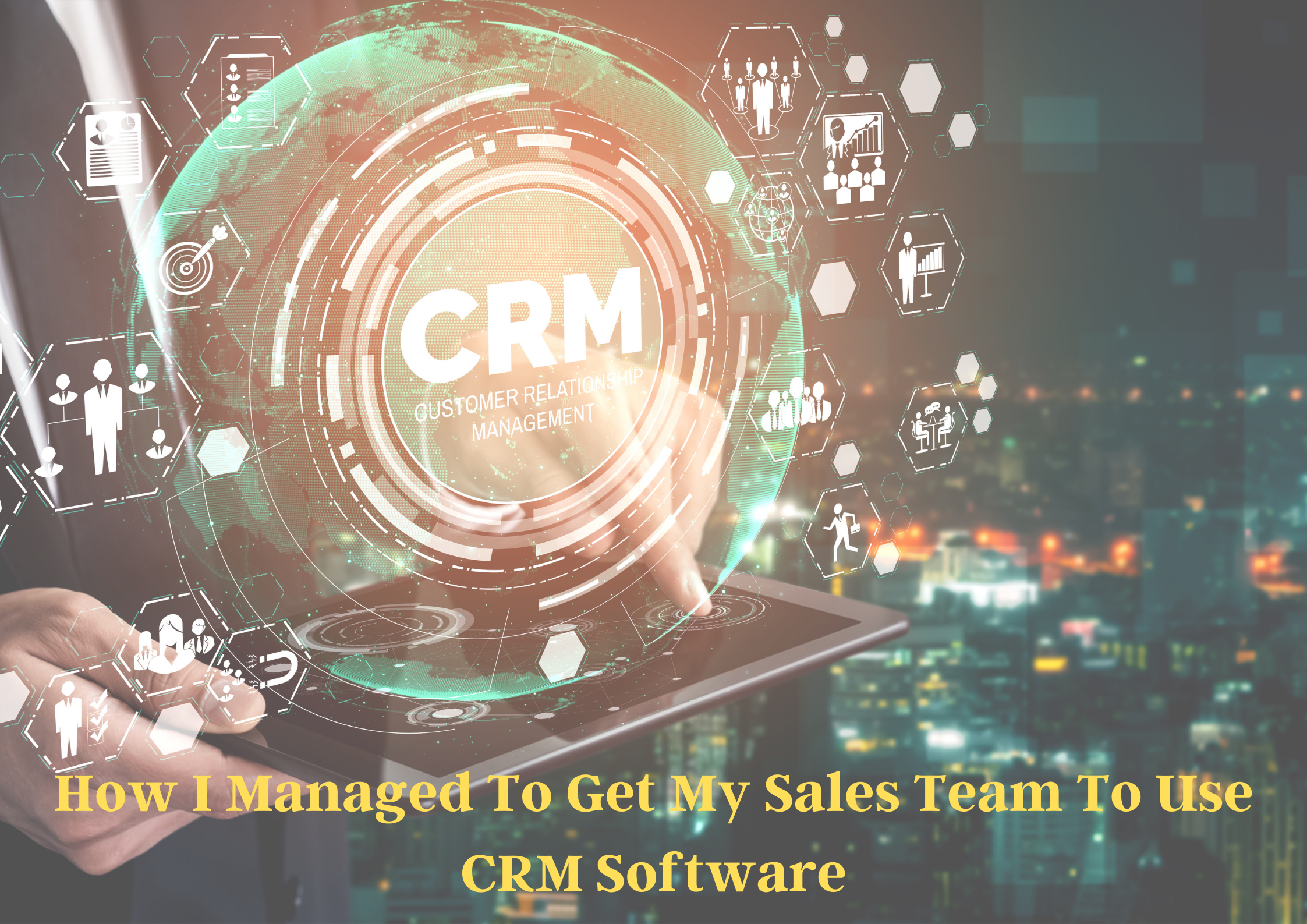A CRM system can be extremely beneficial to staying organized and knowing where in the sales process a particular client is at any given time-but only if your sales representative are actually using it.
However, despite CRM’s obvious advantages, salespeople are often reluctant to adopt it. Why is that? Since it has traditionally only benefited senior management rather than the front line rep, it feels too much like additional work.
Once sales people become proficient with CRM, they will begin to see the personal benefits of using the platform. A sales leader must be persuasive during the introduction and training phase to persuade those unwilling to use CRM to take advantage of it.
Today’s CRMs are truly remarkable technological feats, capable of enhancing the efficiency and productivity of entire organizations. Aberdeen Group research indicates that effective sales organizations are 81% more likely to consistently use a CRM or system of record. Slow or negligible user adoption rates of CRM lead to inefficient business processes. CRM usage for salespeople and their teams has been proven to:
- Drive sales and marketing teams to increase sales lead quantity and quality.
- Automate and streamline the sales activities, resulting in the closing of deals in sales pipeline.
- Achieving higher close rates through better collaboration between marketing and sales
- Optimize renewals and upselling opportunities by aligning operations and customer service.
- Inconsistency and dissatisfaction with prospects and customer experience is reduced.
- Increases sales productivity day-to-day.
Here are a few ideas that might make it easier for your sales team members to adopt CRM if your sales team’s reluctance to use your CRM is limiting its power.
The ways I got my sales team to use CRM
Once you have invested in a customer relationship management platform, you don’t want it to go unused. It is very common for sales teams to push back against CRM implementations.
It is more common for employees to resist CRM adoption due to poor implementation than unusable systems. In order to avoid future pushback and ensure widespread CRM usage, you should design the CRM adoption process with your sales department in mind and follow the right steps to ensure buy-in early on. It is possible to get your sales team on board with the new system and its new processes, however, with a bit of effort. We’ve put together eight tips that helped me manage sales team members to get them on board.
1. Demonstrating the CRM’s benefits to sales teams
A CRM is going to be useful to your sales team first of all, so you need to tell them what it will accomplish. In order to break down any barriers they may put up, you must show them what they can expect when using the tool. The following are key benefits they should be aware of:
i. Reports can be automated with CRM
By showing them how a CRM removes the need to manually create reports out of multiple spreadsheets. It allows them to enter sample data and see how it would work for their daily tasks. It addresses a common pain point faced by many salespeople, who dislike submitting reports and compiling them.
ii. Customers’ data is centrally stored in CRM.
Information including customer contacts, notes, and sales history is gathered here. Having centralized information makes it easier for sales teams to refer to it more quickly. Explain to your sales team that inputting that data into your CRM eliminates the mistakes you’ve made in the past.
If you intend to use CRM to automate contact management or make data more accessible to your entire team, prioritize these features first.
iii. Set up reminders for follow-up appointments with your CRM.
Salespeople also struggle with managing their calendars. CRMs enable them to keep track of appointments more efficiently so they don’t miss them.
2. Adopting a rewards system to encourage adoption- Incentivizing the behavior
It’s guaranteed that you’ll have less employee pushback when you make CRM user adoption fun and filled with perks. When the software launches, introduce a CRM rewards system to motivate employees to take part right away. As time passes, you can assess whether you still need a rewards system. It may be enough to offer rewards for the first month to encourage your employees to participate. As an example, you might give your employees cash bonuses or gift cards if they:
- Bring in the most new leads in your CRM
- Provide at least 20 quotes to prospects
- Sign a minimum of 10 proposals via e-mail
- Follow up with 50 prospects by text
- Are most active on the CRM chat interface
- Use the automated email templates to send 50 or more emails to prospects
3. Involving the sales team in the decision-making process
Failure to involve sales in the implementation process will result in problems in the future. The decision to purchase a product isn’t usually made democratically, nor should it be, but choosing a few tech-savvy salespeople to sit in on demos can help get buy-in from other colleagues. As well, having senior sales staff and managers on board early provides an excellent support system for associates who are more resistant to change.
Include a representative from any team (or team subset) that may have individual concerns or motivations. As an example, you could include both senior and junior members of the sales team, as well as someone from sales enablement, sales operations, and revenue operations.
4. Get feedback.
Even though this may not be the first time you hear this, it needs to be said: pay attention to what your employees say. Their opinion will shape whether or not the CRM software is a good choice since they will be using it directly.
Is the CRM software integrated with the sales process? How easy is it to learn and use? Can problems be resolved quickly if they arise? Is it likely to succeed in the future? These are all excellent questions to ask your employees.
They can reduce the number of features, or buy add-ons that best fit their needs, if they encounter problems or feel that the software is not enough. This is also where a CRM Stars will come in handy, since they will know how your CRM and sales process works inside out. Organizing competitions within a company can increase adoption rates for business owner.
Continually improve your CRM and sales process by utilizing your team’s feedback.
-
- The sales team is the one that will be using the CRM software the most, so be sure to listen to them.
- Have them offer their opinions on what’s working, what’s not working, and how the software could be improved.
5. Develop Productive Habits From Day One
Using the CRM may come naturally to some people. Their day-to-day activities include updating contacts, accounts, and tags in their CRM automatically. Utilizing the CRM is seamless and bringing the benefits from it is seamless as well due to productive work habits. Other workers leave unentered data in a backlog, some of which is already outdated, as a result of bad work habits.
Call out the best practices of your “CRM stars” (ideally those who are also atop the sales leaderboard) when you onboard new team members so that they are highly motivated to build good habits quickly. To ensure habit-building follow through, it’s also good to monitor CRM usage closely during the first few months.
6. Highlighting success stories
Is anyone in the company excited about the CRM and eager to use it? Bring them forward to share their experiences and advocate for the software. They should show you the little wins that a CRM creates, even if it is as simple as automating follow-up emails after the initial contact.
Look for salespeople who are hitting or exceeding sales targets thanks to the software’s efficiencies. Get their stories in an email or in a meeting. The more success you can demonstrate to your sales team, the more likely they are to adopt the system.
7. Making CRM available on mobile devices
It is important that sales reps have access to their CRM wherever they are. It is imperative that their CRM system be accessible and usable on mobile devices, such as laptops, tablets, and smartphones. No matter what the mobile tool of choice is, the CRM must be easily accessible and usable by the sales person-whether through a simple user interface, a chatbot, or an email client.
For instance- After meeting with a potential customer and the customer asks for a sales forecast to determine if this will be a wise investment, your sales person can pull up this crucial information right on the spot using Zoho’s mobile CRM app.
8. Emphasizing the important and reducing sales cycle.
Sales reps can focus their efforts on accounts that have the potential to close the fastest and be the most profitable with AI-enhanced lead scoring and opportunity assessment. The CRM system can identify product gaps, as well as recommend upsells and cross-sells, so conversations can continue and opportunities can be pushed down the funnel. Furthermore, if the CRM system can identify sales opportunities (based on an ideal customer profile, for example), then the value is even more evident, and the job of your sales team has been simplified and streamlined.
Conclusion
Even after you have tried everything to encourage your salespeople to use the CRM, some may still resist. Even if they try to get around having to use the system, you can’t let them get away with it. The tool can only serve its purpose if everyone uses it.
A key to success is framing the introduction (or switch to) of a new CRM system as a way for your sales team to gain improved performance and productivity. Bring your team along as you test systems, provide hands-on training, and review usage regularly as you choose the best CRM.
Since every team is different, remember that this is just a suggestion. If CRM software is maintained regularly, it can be an effective tool for sales teams. As a result, sales manager should inform their teams about how Customer Relationship Management software can make their lives easier.
A CRM system organizes data, contact record, and contacts based on targeted and segmented groups of customers, provides customizable charts and reports that clarify your business’s direction, and integrates with other software so it never strays too far from the sales process.
The eight things sales managers can do to encourage CRM adoption are all effective because they keep the focus on the sales team.




